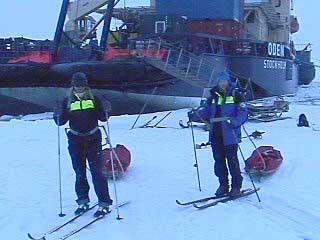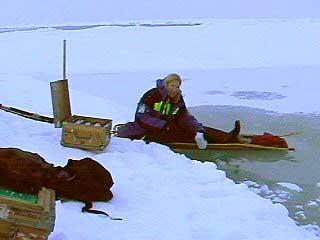
|
|
20 August, 2001
Greenish Yellowish Water
Monday, 20 August 2001
God Dag!
Life on Board
Even though we have had aerobics class several times each week, one of the
women in the Physical Oceanography group, Anna Nikolopoulos from Stockholm
University, and I decided to make a new workout class: Boxaerobics!
Neither of us has ever taught it before, but both of us have taken the
class at our own clubs for years. So, we decided to make a boxing tape
using some of the CDs onboard and create a workout. Today was our second
class and people seem to really like it. It is different from the regular
aerobics class and these days, anything new or different sounds pretty
good. It is great sweaty fun and you get to work out all of those
aggressions!
Where Are We Now?
Yesterday was just a packing up day. Today, I got my GPS back from Tuomo
after he successfully mapped out all of his ice drilling sites. At 1:00
pm, we were at 88o11' N by 8o51' W. We ran the gamut of weather today,
starting off early with fog and no wind, like being in a whiteout. Then
the wind came up and the sun came out, but shortly thereafter, real clouds
moved in and it started to snow lightly. The wind dropped off by
mid-afternoon, the temperature went up a little and it started to snow
those big, clumpy snowflakes that fall straight down and stick. It was
really pretty, like a Christmas scene except that it is August. Because of
all of the variable conditions, we turned the ship 90 degrees at 4 pm so
that the bow was still facing into the wind. Even though most of the
scientists are starting to pack up their equipment, the aerosol sampling
group will take measurements until the last possible moment. We are still
scheduled to depart this site tomorrow morning at 10 am.
Scientists at Work
All over the ice, there are beautiful turquoise pools formed by the ice
melting. Amazingly, these pools are called melt ponds. They usually have
very low salinity since most of the salt has been rinsed out of the top
layers of ice, concentrating further down in brine pockets. Two of the
scientists in the Remote Sensing group, Bertil Hakansson and Maria Lundin
from the Swedish Meteorological and Hydrological Institute, found and
sampled a greenish yellowish melt pond during their daily travels around
our ice floe, where they constantly monitor the radiation or energy
reflecting from the ice. All of the biology/chemistry scientists got
really excited about this melt pond and wanted to collect samples from it
before we go. That would have been a great idea except that it is a couple
of kilometers away and both of the snowmobiles were being used to bring
equipment off of the ice from the ice camps. So, Johan Knulst and I got
out skis and sleds (or sledges, as they are called, for hauling stuff),
loaded up sample bottles and plastic bags, and followed Bertil and Maria
out across the ice floe. Actually, Maria and I pulled the sledges out with
the understanding that the guys would pull them back.
When we located the pond, Maria and Bertil went off skiing and Johan and I
dragged an empty sledge partially out onto the inch-thick ice covering the
pond to get away from the snow-covered edges. These ponds are usually only
a foot or two deep so we weren't in any danger, but we preferred not to
take a subzero bath. Sitting on the sledge, we filled about 90 1-Liter
sample bottles in 3 wooden cases. We also had 2 large water containers
(called carboys for some odd reason) to fill. A scientist from Estonia,
Kalle Olli, had found some fresh-water organisms, flagellates and ciliates,
in the small sample collected earlier by Maria and Bertil so he wanted us
to also collect some of the surface ice so he could look more closely at
these organisms and try to determine their origin. So, we also had 10
large Ziploc bags for ice samples.
OK, budding scientists out there, do the math. We had about 120 Liters of
water, 10 bags of ice, 2 carboys, and 3 large wooden cases. Water weighs
about 2.2 pounds per liter. Would you want to drag it 2 kilometers across
the ice on skis in heavy snowfall? I didn't think so. With this in mind,
we left the wooden cases and the carboys next to the pond with an orange
rubber boot stuck on a stick next to the pile of samples for a marker.
Thankfully, we were able to talk one of the snowmobile drivers into going
out and collecting it later in the day.
Tomorrow we leave!
Vi ses! (See you later!)
From Deck 4 on the Icebreaker Oden, packing it up, north of 88,
Dena Rosenberger

Maria and I loaded up and ready to mush!

Collecting melt pond water samples.
Contact the TEA in the field at
.
If you cannot connect through your browser, copy the
TEA's e-mail address in the "To:" line of
your favorite e-mail package.
|
